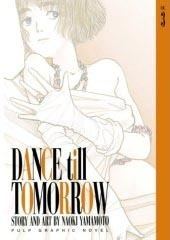Dance till Tomorrow
8 /10 1 Votes8
Director Ryuichi Honda | Genre Romantic comedy Duration | |||||||||||||||||||||||||||||||||
 | ||||||||||||||||||||||||||||||||||
Release date December 1, 2005 Writer Naoki Yamamoto, Masahito Kagawa | ||||||||||||||||||||||||||||||||||
Dance till Tomorrow (Japanese: あさってDANCE, Hepburn: Asatte Dansu) is a Japanese manga series written and illustrated by Naoki Yamamoto. It is a romantic comedy which details the life of Suekichi Terayama, a student who will inherit a fortune when he graduates from college and gets married with unexpected complications from a mysterious girl, Aya Hibino.
Contents
The manga was originally serialized in Shogakukan's Big Comic Spirits magazine from 1989 to 1990. The first five volumes were published in the now-defunct adult manga magazine Pulp, and the rest were released afterward under Viz's Editor's Choice line. It has also been adapted into two live action films, and in a two-episode original video animation (OVA).
Main
Other
Production
Dance till Tomorrow was described as "boy-meets-girl-story" by Yamamoto, who created it just following a trend among young-adult comic magazines. He declared, "I must have unconsciously put myself inside some boundary, thinking I had to do some thing like that." Nevertheless, he tried to have an alternative to the common place "mediocre happy ending" and the "tearjerker separation" on its conclusion. After ending it, "[he] felt like [he]'d done enough in a commercial genre".
The character of Aya Hibino was not based on any real person, although her thick eyebrowns were inspired by idols' style in the 1980s. Yamamot said she was meant to be a femme fatale and "probably somehow represents [his] own deep-seated feelings of not being able to understand women".
Manga
Dance till Tomorrow was originally serialized in Shogakukan's Big Comic Spirits magazine between 1989 and 1990. Shogakukan later compiled its individual chapters into seven tankōbon published between September 1989 and February 1991. It was re-released twice; Yudachi-sha published seven volumes from March to September 1994, while Ohzora Publishing released it into four volumes between November 25, 1998, and February 17, 1999. It was licensed to North America by Viz Media and serialized in its adult oriented magazine Pulp from the first issue in December 1997 to the last issue in August 2002. After having already released five volumes through Pulp, the last two volumes were published in straight-to-graphic-novel format in Editor's Choice line.
Adaptations
It was adapted into a two-episode original video animation (OVA) by Knack Productions that was directed by Teruo Kogure and Masamune Ochiai. The first part, produced in 1990, was released on VHS on July 25, 1991 while the second video was released at an unknown month in 1991.
In 1991, studio Daiei Film adapted it into a live-action film directed by Itsumichi Isomura, starring Tomoko Nakajima and Tamotsu Ishibashi and released on June 22. It was released on VHS by Daiei on November 25, 1991, and then re-released on January 14, 1994. This production was elected the third best film of the year at the 1st Japan Film Professional Awards.
In November 2005, a live-action film directed by Ryūichi Honda, based on the series and starring Hiroaki Matsuda and Ai Kurosawa, was announced. A trailer was released on its official site on December 5 to promote the film, which debuted on December 10. Divided into four segments it was released as a DVD box set on March 23, 2006, as well as four individual DVDs on April 26, 2006. This adaptation was released in North America under the title Naughty Gold Diggers by Asian Media Rights on November 27, 2012.
Reception
Adam Arnold, writing for Animefringe magazine, described it as "a sex comedy that puts anything on TV to shame." Jason Thompson, author of book Manga: The Complete Guide, wrote "Yamamoto's art has a gangly, hand-drawn look, and the whimsical, self-referential story provides opportunities for surreal, artsy humor." Thompson concluded calling it "loosely plotted but enjoyable and unpredictable." Author Shaenon K. Garrity declared it is "almost too smart to be a manga: it's cheerfully cynical, it's self-aware, there's real sex, ... , and the characters feel real and unforced." Garrity praised the first two volumes as "especially amazing, a comedy balancing act of money, sex, and power" and how Yamamoto developed and its characters. Inside Pulse's Jimmy Lin praised its characterization, as Yamamoto created "wackos, weirdos, and other kooks", and said it "hits an emotional key ... when it takes on its soap-opera notes." Lin commented that "even at his most tangentally [sic] cogent, Yamamoto draws you in and keeps you in with his strong sense of character and weird sense of humor and story."
References
Dance till Tomorrow WikipediaDance till Tomorrow IMDb
